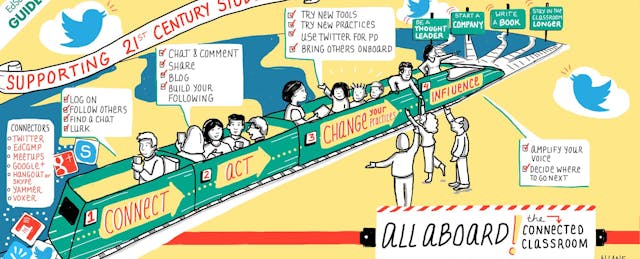All aboard!
Learning--for both students and teachers--is increasingly connected. We share learning practices, lessons and insights both to support one another and sometimes just for the sheer joy of it.
Throughout " Connected Educators" month, we'll share articles, tools and resources on this fast-track, four-step journey to create authentic learning for students and educators.
- Getting Connected: Where do you start?
- Taking Action: From lurking to participating
- Changing Practice: Applying your learning
- Expanding Your Influence: Where do you go?
We're joined by others creating amazing resources for educators during this special month. For starters, the American Institutes for Research, with funding from the U.S. Department of Education, has developed an extensive set of resources at Connected Educators, including:
- For teachers, the Connected Educator Starter Kit (PDF), a treasure trove of resources and activities to help you use free, everyday web tools to turn the wild, wild web into a powerful, personalized professional learning community;
- For administrators and district officials who want to lead by example, the District Toolkit (PDF) offers ways to engage staff in connected learning.
Hang on tight! You're on a voyage to discover what it means to be an educator--and a learner--in the 21st century.
Get on the fast track!
Want to find like-minded educators? Check out our new tool, EdSurge Reflect & Connect.
It's a short, three-minute quiz, and based on your responses we'll give you recommendations about who to follow on Twitter, relevant Twitter chats and hashtags and EdSurge content tailored to your interests and priorities. (Yep, all free!) You only need a Twitter account to get started.
Step 1: Getting Connected
| Popular tools used by teachers to connect (available on both mobile and desktop) | Price |
| Twitter: Get started with the basics. Use this tool to share and find quick thoughts, resources and opinions from your own curated list of Tweeters! | Free |
| TweetDeck: This tool helps you schedule your Tweets, create lists that help your organize your friends and followers, and follow your favorite hashtagged conversations. | Free |
| HootSuite: In addition to features offered by TweetDeck, HootSuite allows you to monitor multiple social accounts (including Facebook, Google+ and LinkedIn) at once. And it offers analytics data to let you know your reach. | Freemium; plans start at $9.99 per user per month |
| Voxer: It's basically like a group walkie-talkie! You can create groups, record your voice and listen to what others have to say. Almost as good as an in-person conversation. | Freemium; plans start at $2.99 per user per month |
| Yammer: Ever wanted to crate your own private Facebook? Well, that's kind of how Yammer works. Popular among teachers, this tool lets you create private groups, share comments, send messages, documents and even post a poll. | Freemium; plans start at $3 per user per month |
Step 2: Taking Action
Activities and Resources
One of the most popular host and destination for teacher blogs has compiled a series of simple, ten-step professional development challenges to help you build a following:
- Start off with the “Build a PLN” (professional learning network) challenge to see how you can build a following through blogs and Twitter, and...
- ...then bring it back to your class with the “Blogging with Students” challenge and see how to help your class connect with others around the world
Edutopia's Resources for Connected Educator Month 2014
The fine folks at Edutopia have compiled quite a collection of resources to get you connected and learn about DIY professional development.
Take your students on a virtual field trip via Google+! Here are the step-by-step instructions (PDF) on getting your class set up and ready to explore the world, from Monticello to Tanzania.
Where in the world is your classroom? This video guessing game invented by two teachers is simple: two classrooms connect via Skype and try to guess the location of the other by asking questions.
The Weekly Twitter Chat Schedule
This mother lode collection of weekly education chats on Twitter can be intimidating, so we’ve put together some of the most popular ones here:
| Chat |
When |
Facilitators |
|
EdTech Chat (#edtechchat): Everything edtech. |
Mon 8-9 pm ET |
@thomascmurray, @KatrinaStevens1, @iplante, @s_bearden, @ajpodchaski |
|
EdChat (#edchat) The granddaddy of educational chats; educators come from near and far to talk shop. |
Tues 12-1 pm and 7-8 pm ET |
@tomwhitby, @web20classroom, @ShellTerrell |
|
Project-Based Learning Chat (#pblchat) Project Based Learning isn't as easy as it looks. Here's where pbl practitioners come to collaborate. |
Tues 8-9 pm ET |
@theresashafer, @TeachInDurham, @emergentmath |
|
Instructional Coaching Chat (#educoach) PD coaches share the secrets to making teachers better. |
Wed 4-5 pm ET |
@kathyperret |
|
Parent-Teacher Chat (#ptchat) Bringing families and schools together, this chat gives educators and parents a place to come together. |
Wed 9-10 pm ET |
@Joe_Mazza, @ZakMal, @GPescatore25, @Sirotiak02, @SMConstantino |
|
New Teachers Chat (#ntchat) When you're new, you need support more than ever. This is where new teachers find it. |
Wed 8-9 pm ET |
@yomsdunn, @MrDKeenan, @JaimeVandergrift, @dmantz7 |
|
Saturday EdChat (#satchat) School leaders from all around grab an cup of Joe and sit down to tweet. |
Sat 7:30 am and 10:30 am ET |
@bcurrie5, @scottrrocco |
Step 3: Applying Your Learning
Activities and Resources
How to Start & Run Your Very Own EdCamp (PDF)
The coolest professional development conference on the block is...an unconference. That's right. EdCamps have become a favorite among educators looking to connect and collaborate with like-minded individuals to share and brainstorm ideas for the classroom.
Step 4: Expanding Your Influence
Activities and Resources
Check out over 400 jobs from leading edtech companies and schools leading the blended learning charge. There's a role for teachers in every startup; by our latest count, nearly one-third of openings are for educators and edtech coordinators.


